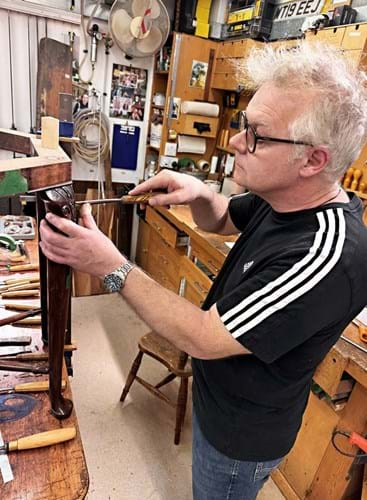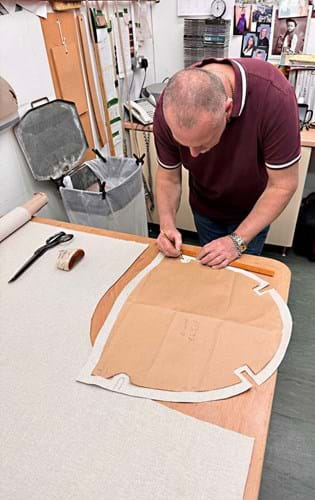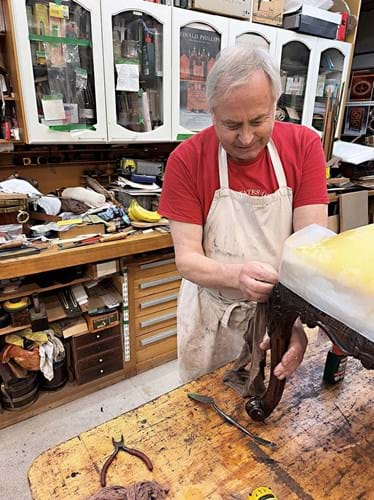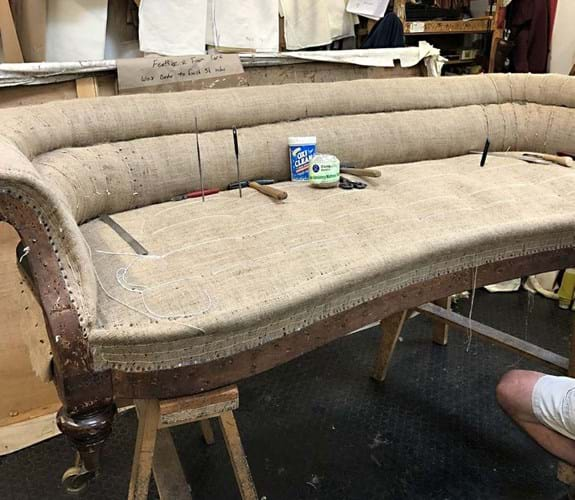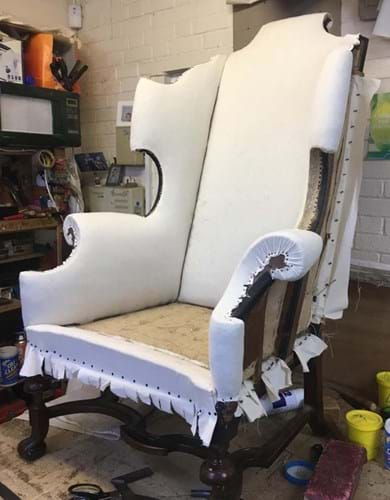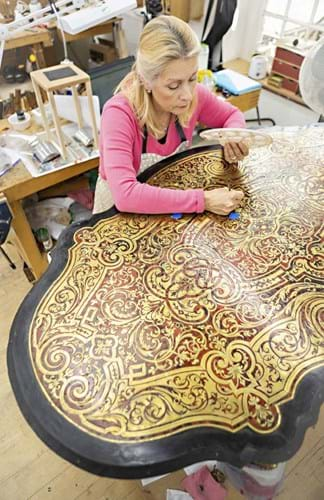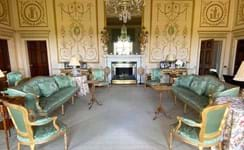Just a few steps from Berkeley Square in the heart of Mayfair, surrounded by luxury fashion brands, lies a bunker containing some of the secret weapons of the antiques furniture trade.
Beneath the grand façade of high-end furniture dealer Ronald Phillips, in the former premises of queen’s couturier Norman Hartnell, is a hidden workshop.
This subterranean hive of activity is the domain of a group of craftsmen entrusted with centuries-old specimens of the best pre-19th century furniture destined for the grand houses of the world.
With decades of experience between them, Ronald Phillips’ restorers, Guy Haste and John Russell, upholsterers Stephen Hoar and son Freddie, and gilder George Bird, are a rarity in central London.
Haste explains: “When I started 30-plus years ago it was still a boom time for London antiques dealers. But since then many dealers have retired or moved and the middle market has dropped completely.”
This has been aggravated by the rapid increase in property prices in central London, meaning that many dealers could not afford to run a gallery in the centre of town, let alone have room for a full-blown workshop too.
Ronald Phillips, run by second-generation dealer Simon Phillips, sells high-end 18th century English furniture so his team of restorers have the cream of the crop to work on.
In house is furniture restoration, upholstery and gilding and the team use external specialist gilders, metalworkers, needleworkers and lacquerworkers.
In recent years there have been accusations in some parts of the antiques sector that items of furniture are being ‘over restored’. What does a professional restorer have to say?
Haste says: “We don’t like the words ‘over restored’. Over restored is difficult to define. There are instances, particularly that have happened in the US, where it is more common for pieces to be overcleaned and refinished. It can be at the hands of the owner of the item insisting it is done.
“But we don’t sell furniture to just place in a room. All our chairs you can sit on, if it is a chest of drawers you can fill it, and book cases and tables can be used as they were intended. We are restorers not conservators. Museum condition usually means you can’t use it.”
Of course, restoration, good and bad, has been happening for hundreds of years.
Fashion plays a big part. In the past it has at points been more acceptable to completely change a piece to suit the current taste. This includes the late Victorian trend of painting items funeral black or into the early 20th century when pieces were sometimes completely re-sanded and refinished.
Haste adds: “If this happens today it is because the owner does not know they are wiping the value off the item by changing it to that extent.”
An important part of Ronald Phillips workshop’s work is checking for ‘fraud’ or over-embellishment on items that are candidates for purchase.
Over the years there have been scandals involving forged furniture and now the very best pieces will be scientifically tested to ensure they are the genuine article.
But embellishment can be as simple as replaced handles.
In the past some wealthy families falling on hard times would have their heirlooms copied to sell the original and keep the copy. Gradually this significant information is lost and subsequent generations of the family believe they have a genuine antique when in fact it was copied in the late 19th century.
Restorers and dealers have to be on their toes.
In today’s market, more and more clients are realising the value of not over-restoring items to look brand new.
However, there are areas where work must be done, for instance on delicate and fragile gilt surfaces.
Stephen Hoar adds: “Upholstery is different altogether. Original needlework is repaired and re-backed so it can actually be used and sat on.”
Respect the object
Richard Coles, director of 18th century English furniture dealer Godson & Coles in Fulham, west London, says: “People are now more conscious of not interfering with the original article. We do a huge amount of research as we only want to buy original, untouched patina.
“Years ago everything was repolished. Now it is about keeping the original. People are now respecting the object more.”
He adds: “For instance, with painted furniture we will do scientific analysis of what the original is and how it is changed over the centuries. Then we discuss how we proceed: do we leave it or remove some of the later changes. We take it really seriously.
“More buyers are interested in the originality of a piece. If we get something that has survived the centuries untouched sometimes we won’t even wax it, just a touch of a dry cloth. Authenticity and originality is key.
“There is a polarisation of the market so when you get these rare pieces the price is so very high.”
Coles acknowledges that as the market has contracted there are inevitably fewer restorers. And fewer furniture dealers in central London means that the restorers move out to more reasonably priced premises.
Among those businesses working around the suburbs of London are RD Robins Upholstery in Epping, Plowden & Smith in Mitcham, Hatfields Restoration near Brixton and W Thomas Restorations in Wimbledon.
Highly prized
With so few specialist antique furniture restorers in operation now, those working with the best dealers are highly prized and closely guarded.
Barry Ansell, owner of RD Robins Upholstery, says: “Clients don’t want me to say what I have worked on and they don’t want me to share information. It is a closely guarded secret.”
Ansell, who has 40 years’ experience in furniture conservation, has seen a lot of changes in the sector. In 2017 the company moved to a purpose-built workshop overlooking the green fields outside Epping, Essex. Ansell works with his son Tobias and employs seven staff.
Around 20 years ago he had many antiques dealers as clients (such as Norman Adams, Christopher Gibbs and Mallett) and did lots of work with the US. But over the years his client base has moved toward decorators, interior designers and historic homes with clients including Colefax & Fowler and Chatsworth House.
As well as upholstery and restoration, the firm makes new furniture to traditional designs using original methods such as kaliko and horsehair.
Ray Dudman of W Thomas Restorations has worked there for nearly 50 years and took over the firm in 2010. It originally specialised in carved gilt wood mirrors and such was the demand, that was pretty much all its work consisted of for many years. As times changed the focus moved to wider restoration, conservation, gilding and woodcarving.
But like others, Dudman is concerned about the future of the sector.
He says: “In the past people came through colleges, City & Guilds, art school and YTS training schemes. But firms aren’t taking people on now and there are fewer places to train.”
Dudman adds that a young person is not profitable for five years so it is a financial burden on the company to take them on.
However, he took on an apprentice, Oscar Whapham, seven years ago via art and craft educational trust The Queen Elizabeth Scholarship Trust (QEST and Whapham now specialises in wood carving.
Dudman admits that employment laws make it harder while often work for restoration business is “feast or famine” and instead firms employ people as contractors.
TV shows such as BBC’s The Repair Shop have boosted interest to some extent but often, like with other areas of art and antiques, those that do find their way into the sector have a family connection. At Ronald Phillips, upholsterer Stephen Hoar’s son Freddie has followed in his footsteps while at W Thomas Restorations, Oscar Whapham’s mother works in picture framing and he was aware of the sector through her experience.
But there are opportunities out there and the sector remains an important part of the overall arts sector.
According to the latest The British Art Market Federation’s The British Art Market 2024 report, the art and antiques sector spent $242.4m on conservation and restoration services in 2022 in the UK.
Although this figure accounts for all elements of conservation and restoration (not just furniture) it explains that: “Skills such as conservation and restoration are fostered by the art trade, and have developed into specialised industries of their own, with their own academic and training infrastructure.”
Royal approval
A small number of colleges, courses and training schemes still exist (see below) as well as work experience within established businesses.
For example, a number of opportunities are coming up at the Royal Household’s Frogmore Workshops, in Home Park, Windsor.
Richard Thompson, palaces foreman who works with the master of the household’s department at Buckingham Palace, started in furniture restoration in 1979 and still believes there are careers for younger generations. He is passionate about developing opportunities for those at the beginning of their career; providing a career pathway is paramount to him.
He found his way into the trade through a mixture of doing woodwork and other crafts at school and being advised by a careers office to consider restoration of furniture. After a visit to Castle House Antiques and watching BBC’s Antiques Roadshow on TV he took his first steps into restoration.
Thompson started out in a restorer’s workshop in Somerset and also worked with the antiques dealers of Bradford-Upon-Avon, Bath and Tetbury to understand the trade.
When the 1982 recession hit, he set up his own business, eventually creating a “journeyman experience” working with, and learning from, a French polisher and cabinetmakers and restorers “trying all the elements” to evolve his learning.
By the mid-1980s he had built up a lot of knowledge and when a job came up as a cabinetmaker at Buckingham Palace in the Royal household, he applied and got the job.
With 38 years’ experience within the Royal residences of Buckingham Palace and Windsor, Thompson has worked across departments including the Royal Collection and for the past six years has headed up a branch that has responsibility for day-to-day collection care, furniture conservation and restoration projects, upholstery and soft furnishing and preventative care through its historic interiors teams who are on site at Royal residences.
Valuable opportunities
Since 2015 his team has worked with The Creative Dimension Trust which offers workshops and work experience opportunities for young people to develop core hand skills and understand their career options.
Thompson adds: “We want to attract people into our industry. It is very time consuming but worth it, as we learn a great deal too. We support learners. We gain and they gain.”
In August 2023 a member of the workshop’s gilding team completed an outreach programme with community group Young Gloucestershire in partnership with the Kings Foundation at Highgrove.
In May 2024 Thompson said the workshop is planning to host ‘masterclasses’ for two Saturday clubs (part of QEST’s National Saturday Club programme), which evolved from discussions with QEST who support a range of initiatives in the crafts arena.
Since 2021 the branch has hosted three apprenticeships (a furniture maker, a gilder, and upholsterer), and in that time there has been a range of apprentice learning opportunities - something Thompson and his team expect to explore further in 2025.
In the next two years he hopes to host “additional paid placements to advance those who need a real workshop experience to advance their careers - these will be in partnerships with other groups such as Heritage crafts”.
Thompson adds: “What inspires me is the people, the talent, and their future. Long may Jay Blades [The Repair Shop] and the King’s passion continue to inspire everyone who has a creative talent and a desire to achieve.”
He one day hopes that a “national journeyman network for individuals to gain knowledge and experiences” could be created which “would be a way to extend their preparation for long-term careers in the sector ”.
Training - where to go
There has been a significant reduction in places to study and learn furniture restoration, but some options are available. Here is a selection:
Rycotewood Furniture Centre
Rycotewood Furniture Centre offers a variety of courses in its workshops in Oxford city centre. The provider of all the courses is the City of Oxford College, which is part of the Activate Learning Group. Its degree courses are in partnership with Oxford Brookes University.
West Dean College of Arts and Conservation
West Dean in West Sussex allows students on The Conservation Studies courses to specialise in furniture and related objects. Students are provided with objects from historical and private collections to work on “to acquire and practise both established and developing techniques”.
Examples of recent projects for students have included oriental lacquer boxes and an 18th century chair owned by Horace Walpole from Strawberry Hill Trust. The college adds: “The students have the opportunity to undertake interdisciplinary work with students from other specialisms, for example where an object is mixed materials, to broaden their understanding of a variety of materials.”
The course focuses on “hand skills through practical work” and as part of the course students “document objects, assess their condition, discuss treatment strategies and take part in decision-making. The projects increase in complexity through the course and students work with increasing autonomy.”
West Dean’s specialist furniture workshop is equipped with a full range of power and hand tools and individual workspaces for each student. A dedicated finishing area and a separate machine shop are available. Students also have access to facilities shared with other departments.
Its workshops are equipped for 8-10 students to study furniture conservation each year. The college says that following graduation, alumni have “gone on to set up their own private practice, or to work in UK and International institutions such as the Royal Collection Trust, Royal Museums Greenwich, Maritime Museum Rotterdam and Science Museum”.
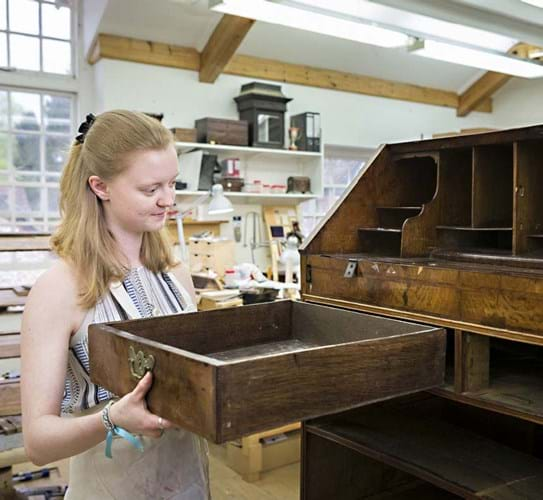
West Dean College of Arts and Conservation in West Sussex has 8-10 students studying furniture conservation each year.
Graduate diploma student Shane Orion Wiechnik says: “West Dean was the obvious choice for me; a furniture conservation programme with a dedication to craft and practical skills as well as a foundation in science and ethical contexts. We get the opportunity to work on actual objects, practising and testing our own hand skills in balance with theory and science.”
Gow Antiques & Restoration
A number of smaller firms offer training courses, including Gow Antiques & Restoration, run by Jeremy Gow.
Among his courses are antique furniture recognition and antique restoration. A member of LAPADA and The British Antique Furniture Restorers’ Association (BAFRA), Gow’s 2024 dates are for three- and five-day courses running in April, May, June and September.
City & Guilds: Vocational Education and Apprenticeships
City & Guilds Furniture and Furnishings NVQ closed in 2021. However, a level 1-3 certificate/ diploma is still available and more than 1000 certificates have been awarded in the past three years. These include diplomas in Furniture Design and Making; Furniture Finish Methods; Furniture Restoration; and Furnishings - Traditional Upholstery. Furniture and Furnishings qualifications are available with 23 centres across the UK, alongside some creative techniques courses offering certain elements of furniture and furnishings.
Unifrog
Search for courses and training information on furniture making and upholstering via
*For tips on buying antique furniture read antiques dealer Richard Coles furniture advice here.*




